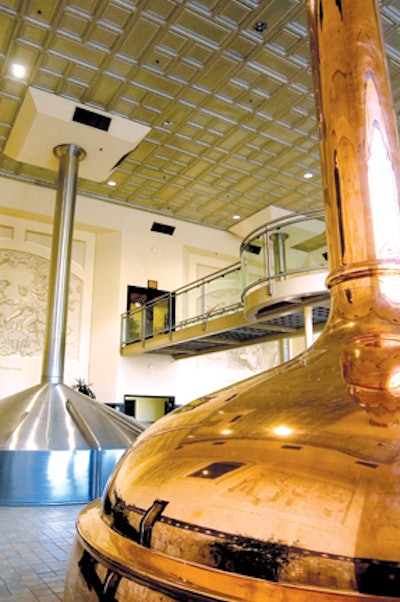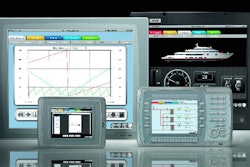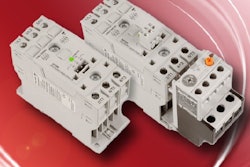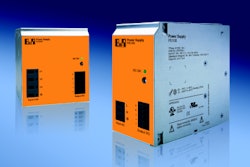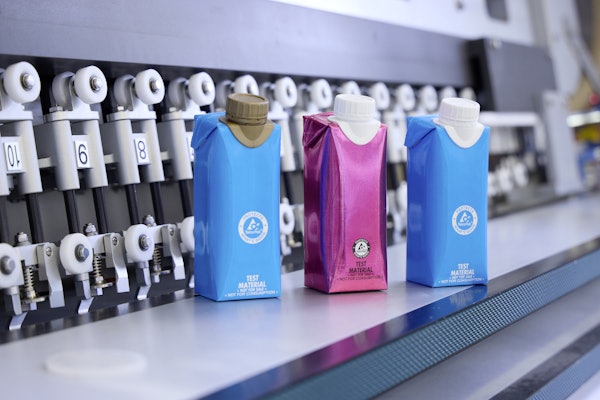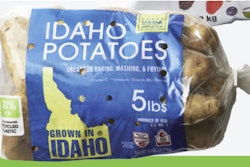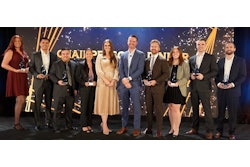First a look at Byrne Dairy’s Ultra Plant, so named because everything it produces is ESL (Extended Shelf Life) product with roughly a 90-day refrigerated shelf as opposed to fresh milk or cream that has a shelf life of about 20 days. Seven packaging lines occupy the plant. Four of them produce gabletop cartons, one is a portion-pack single-serve creamer line, and one is a bulk bag-in-box line. The seventh line, running commercially since January of 2009, is significant because it’s the first U.S. installation of a technology from Sidel called Predis. Because it features sterilization of small PET preforms rather than large stretch/blown PET bottles, it offers significant savings in the amount of hydrogen peroxide sterilant that’s required and in the amount of water needed for rinsing.
“I’m impressed with the extent to which systems are integrated together at this plant,” says Byrne Dairy process engineer Mike Sima. “A lot of extra time and effort was invested in making sure that all personnel, regardless of whether they are interacting with packaging or processing, are not doing something that will have a negative impact somewhere else in the plant. The controls systems implemented here are designed to prevent product loss, cross contamination, and other problems that commonly surface in operations that are more manual in nature and, consequently, less integrated.”
The flow of materials from incoming raw product to outgoing packages involves five main steps:
• Receiving and raw materials storage
• Batching (for most single-serve items) or Separating (for whole, skim, or 2% milk)
• High-Temperature/Short-Time thermal processing
• Storage of ESL-processed product in All Safe buffer tanks
• Packaging
The Processing part is done by two Vacutherm Instant Sterilization systems from Tetra Pak. Raw ingredients are fed from eight huge tanks into either the separating system or into batch tanks. The VTIS systems are the next stop in the process, where high-temperature/short-time thermal processing and cooling is initiated. It doesn’t take long either: 4 seconds at about 285 deg F., which is followed by cooling.
Once processed, product goes to buffer tanks that are called All Safes before heading for a filler. Product only goes to a filler if the filling line is ready. The packaging line isn’t in a “ready” state if it’s already running another product or if it hasn’t gone through its CIP process. In what might be called the “old” days, people with paper-based documents would be responsible for reading documentation at a filling line confirming that the line was in a “ready” state. That person would then go back to the processing area and match up the tank holding the appropriate processed product with the packaging line waiting for that product. In this manner, product flowed from processing to packaging.
Ethernet replaces ‘sneakernet’
At Byrne’s Ultra Plant, Ethernet connectivity replaces the human beings who used to carry the status information from the packaging lines to the processing area. Sima explains, using the Sidel PET line as an example.
“As part of the communications system that links the All Safes with the Sidel filling line, a signal is automatically sent from the filling line to the appropriate All Safe from which the filling line is asking for product.” The signal tells the All Safe to send or not to send product, based on the filler’s status. Two immediate benefits to this communications link are that it’s faster and it minimizes or reduces the chance for operators to misread some part of their documents and, consequently, send product from the wrong All Safe to the filling line. An added benefit, says Sima, is related to overall productivity.
“Suppose the PET line has a jam or hasn’t finished its CIP routine,” says Sima. “This crucial information is automatically communicated back to the All Safe systems and subsequently to the upstream VTIS systems, which in turn will automatically direct the product they just processed into a second All Safe tank where it can sit until it’s time for it to be sent to the filler. That frees up the VTIS systems for the next product to be thermally processed. What it comes down to is that because information exchange is integrated in this fashion, we’re able to go more quickly from processing in the VTIS systems to cleaning of those systems and back to processing a new product in them.”
According to Craig Reinhart of Tetra Pak, the Ethernet connectivity at Byrne Dairy that already provides so many benefits in linking processing and packaging is going to prove its value all over again as the U.S. Food & Drug Administration and the Food Safety Modernization Act call for more treaceability where food products are concerned. “That track and trace information needs to be recorded somewhere, and the coordination of that information into a plantwide data accumulation system is going to become more important than ever,” says Reinhart. “Ethernet connectivity and the overall controls systems that have been implemented at Byrne Dairy lend themselves to precisely this kind of thing.
“Also,” he continues, “data on the packaging side ties into the Tetra PlantMaster system. So all of this food manufacturing information, both processing and packaging, can be gathered and managed through a Manufacturing Execution System (MES) or Enterprise Resource Planning (ERP) system, from Receiving all the way through Processing and Packaging and right on into Warehousing and Distribution.”
A final word on Byrne Dairy comes from chief operating officer Nick Marsella. He notes that the controls systems linking processing and packaging have played a key role in driving efficiency on the new Sidel PET line. “In some cases we’ve been able to run at over 90% efficiency,” says Marsella.
That kind of performance is tough to pull off when the interlock between processing and packaging is a dry erase board or a pad of paper.
Software bridges a P2P gap
Speaking of dry erase boards, use of them by the folks at Sierra Nevada Brewery has been greatly curtailed since the implementation of FactorySQL and FactoryPMI software from Inductive Automation.
Located in Chico, CA, Sierra Nevada is the sixth largest brewery in the U.S., and their flagship product is Sierra Nevada Pale Ale. Before the Inductive Automation software arrived on the scene, the lines of communication between filtration and packaging were not very good. This was a serious problem because before a tank of beer is ready to be packaged, it has to be processed by the filtration department and then sampled and tested by the lab. Until the new software was implemented, the test information was hand written onto a series of dry erase boards around the plant. Packaging workers would first verify what had been tested according to the dry erase boards, then they’d begin the process of packaging.
As the plant grew, people had to remember to write that information down in more and more places. It was a time-consuming task, and it was too easy for people to forget to write something down. Distance became an issue, too, says David Lewis, business analyst at Sierra Nevada.
“Filtration and packaging are now separated by as much as a quarter mile,” notes Lewis. “By the time you got the information from filtration, wrote it down, and returned to packaging, the status back at filtration could easily have changed.”
The Inductive Automation software lets Sierra Nevada build web-launched client screens. So data on filtration tanks can be accessed by all departments—QA Lab, Filtration, Packaging--seamlessly and simultaneously. Lab test data is collected automatically from lab devices connected to FactorySQL, which are then combined with production line information on tank statuses, levels, and other process data. The packaging department can see in an instant if a tank is ready to be packaged or not, and they can be certain that the screen is displaying real time data.
“We were able to take a live database responsible for recording test information, which is separate from production,” says Ron Mayfield, system developer for Sierra Nevada Brewery. “Then we added PLC data—full tank/empty tank—and combined communication between departments. Bringing all that together facilitated communication and workflow immensely.”
No licensing hassles
Lewis is especially pleased by how easy it is to share the functionality of the software. “The whole package is a Web page. There’s no licensing required. Anyone can call up this page anywhere in the plant and see it. You don’t need to be a licensee of an ERP or MES solution that you purchased. We just build these pages and put them out there.”
Lewis also appreciates the real-time visibility into Sierra Nevada’s packaging lines.
“It’s a quick view of the status of a packaging line at any given time,” says Lewis. “And it’s real-time data--as in up to the second--on machine states, total downtime minutes, and so on. That kind of information was recorded on clip boards in the past. When a packaging machine went down, you would hope that someone recorded it. And then you’d hope someone would enter it into the computer so that someone could actually do something with the information. Those are two big hopes.”
There was an intermediate step that Sierra Nevada took in its efforts to migrate away from clip boards and dry erase boards, says Lewis.
“Once we had a wireless network in place, we started doing this information gathering with hand-helds. That eliminated the clipboards, and as long as the people pressing the buttons on the hand-helds were accurate, it was fine. But still you had no guarantee the operator had time, was on the ball, or would enter the information correctly. Now it’s done automatically by the software. FactorySQL is the piece that communicates with the PLCs and captures data into a data base. The FactoryPMI software is more about the Graphical User Interface. It’s very easy to use, but it’s quite powerful.”
Lewis places special emphasis on how FactoryPMI has changed the way he and his colleagues think about building data base interfaces for all the production departments.
“One of the powerful things about FactoryPMI is that it is not only a factory automation software package, it is also a well-rounded data base and application development tool. We therefore have expanded our thinking regarding where we can use it. In fact, we now use it for nearly every software/data base problem we have.”
Lewis says the FactoryPMI software can now be used as a “front end” of any data base that exists at Sierra Nevada. (“Front end” refers to the software used to enter data and view data in an underlying data base.)
“We’re using Factory PMI,” says Lewis, “to tap into the LIMS [Laboratory Information Management System] / QA product-tracking data base that we have been developing over the years, dating from before FactoryPMI was on the scene. That data base extends from raw materials through processing through packaging and right out through to the distributor, and it runs on SQL server. We’ve had a number of front ends for it in the past, from Microsoft Access to Web pages such as asp or asp.net. We’ve now left all those behind and rely on FactoryPMI for these purposes.
“So not only is the Inductive Automation software used to gather data from the production line PLCs, it’s also the tool we use to build data base interfaces for all the other production departments. And because it is the sole tool our development team uses, they can simply and seamlessly bring together data from a variety of very disparate sources, or data bases, and have it work together on one screen.” Figure A, he adds, is a good example of how, on one screen, Sierra Nevada can bring together PLC data, QA testing, tank status data, work flow data, and packaging line decisions all in one place.
Lewis and Mayfield admit they were skeptical about the new software when it first hit their radar screen. Fermentation, after all, is a 24/7 process, so they were nervous about the possibility of new software gumming up the works in any way. Their colleague Jonathan Swisher, a system developer at Sierra Nevada, shared their nervousness.
“When we first bought the software we weren’t sure what it might do to the system,” says Swisher. “We were very cautious about how we configured the network. We wanted to make sure it in no way impacted the operation of the plant. But it was easy to configure because I only had to install it on the server. It’s one install and no clients to install individually. As long as each client throughout the plant has Java and can get to the Web server, they’re good to go.”
Lewis sums up the plant’s experience with the new software this way.
“Everyone agrees the changes are good. It used to be next to impossible to get plant floor data without spending huge amounts of money. Not any more. And this software will only prove all the more valuable as we continue to grow. If we had to make a production decision five years ago, we would simply walk over and talk to someone. Now you can’t always find that person. But you can always find the computer screen. Operation is much easier now.” P2P
